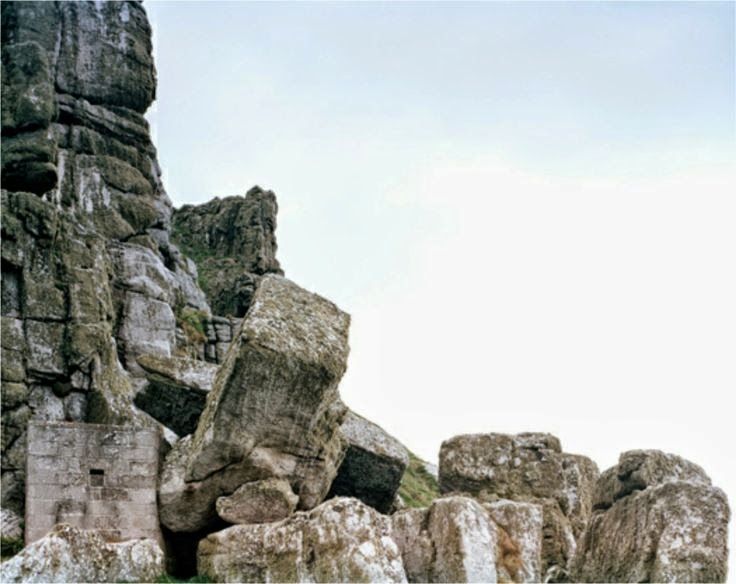Marc Wilson Photographs
Timing is everything in Marc Wilson’s photographs. “You maybe get ten minutes,” he says, “before the sun has come up above the horizon but you have some light, a very soft grey and blue.” The landscapes he shoots are similarly precarious. Wilson’s series The Last Stand documents the remains of coastal fortifications that lined Northern Europe during the Second World War bunkers swallowed by the sea, pillboxes barely clinging to land, buildings ripped from their foundations and wrecked on the rocks from Allied positions on England’s east coast and the far tip of the Northern Isles, to the once German-occupied archipelago of the Channel Islands and the remains of the Atlantic wall, the colossal Nazi defense network which stretched from Norway to Spain.
The series draws attention to places that were once vital to world affairs and have since been left to ruin, their histories obscured or forcibly erased. One photograph, taken in Wissant, France, depicts a bunker that was later declared a safety hazard and demolished by the local government. Wilson is adamant that the sites should be left untouched. He understands the desire to break with the past, he says, “but if you start removing all the physical reminders, then we’ll have no history left. I do not think they should be preserved as such, but they need to be protected from a secondary human interaction. That natural process of time is important.”
That protective impulse is evident in his compositions. In addition to the early-morning light, which flattens out any dramatic shadows, Wilson’s preference for using a large format camera helps to naturalize the elements in the frame. More importantly, the fortifications are always framed in their surroundings: they are never abstracted as pure architecture, and there are no interior views. After selecting a subject, he says, “I’d try and get as far back from it as I could, so I could see it as much within its environment as possible, then walk back towards it until I’d found the right composition where the object sat in the landscape.” At Arrogance Les brains, Normandy — heart of the D-Day landings — he stood further back, “to show more respect.”
Wilson’s images invite the viewer to revisit the scene and plot the traces between the built and unbuilt elements, quietly posing the question of what took place there. The line between natural and unnatural already camouflaged by architects who designed the defenses to blend in with the landscape has been progressively blurred over time, and Wilson’s photographs are studies of buildings that have taken on features of their surroundings: a forest bunker in Lossiemouth, Scotland, is overrun by dappled moss; a pillbox in nearby Find horn is invaded by algae; the bricks of an outpost at St Michael’s Mount in Cornwall, England, are weathered by a sea that does not discriminate between the fortification and the rock on which it stands. Perhaps most troubling is the possibility that it was all for nothing. Borders will be drawn, defended and abandoned for as long as human conflict exists, but the passage of time, as revealed in nature’s slow, disinterested advance, renders the effort to defend them insignificant.
We talk about the ethics of aestheticizing decay. Is there not a risk in making something beautiful out of something terrible? “If someone photographs something that’s decaying for purely visual reasons then I don’t see the point of it,” Wilson says, “because you’re ignoring the history of the place, and if anything is ruined or abandoned then there’s always going to be a history to it.” His aim, rather, is to produce “constant, never-changing visual triggers” stills only in the photographic sense — which evoke a larger history.
When Paul Virilio walked sections of the Atlantic wall for his book Bunker Archaeology (1994), he noted a fundamental shift in military design. Until World War II, he wrote, “Fortifications had always been oriented toward a specific, staked-out objective: the defense of a passageway, a pass, steps, valleys, or ports.” Along the Atlantic wall, however, “You could walk day after day along the sea side and never once lose sight of these concrete altars built to face the void of the oceanic horizon. The immensity of this project is what defies common sense; total war was revealed here in mythic dimension.” Wilson’s photographs play on the pathos of this mythic dimension. Fixed, monolithic, but without solid foundation, many of his concrete altars face at least half a frame of empty expanse — sea or sky. They have been left behind by the war they waged — yet their melancholy watch continues.
The shifting landscape can impede that lookout only temporarily. Should the bunkers become submerged in water or subsumed by sand, Wilson says, “They’ll always be there; we just won’t have access to them. And in twenty, thirty years, they may reappear, as the water levels go down, as the sand dunes shift. So you could have these bits of memory and history constantly peeking out again and then disappearing — a beautiful idea.”















